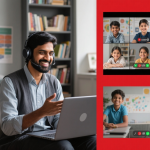- December 13, 2023
- by Educational Initiatives
- Blog
- 0 Comments
COVID-19 has changed many things, including how students learn. Online classes have replaced physical classes in school. Teachers who were once hesitant to try any form of digital learning are now embracing it and even picking up new skills themselves. Parents are stepping up to ensure that their children are not missing out – whether by helping them attend online classes or by enrolling them in other online courses. In addition to regular classes, there are courses on coding, data analysis and other topics which use videos, interactives, one to one mentoring and specialised learning modules.
The question that is missing in all this is “Are students really learning through these multiple modes of online learning?”
In 2001, our company Educational Initiatives (EI) created ASSET with a vision of a world where children everywhere are learning with understanding. The central principle is that effective learning cannot happen without periodic evaluation and feedback. A good diagnosis is a big part of a good treatment, just like a doctor needs to properly understand the problem to prescribe effective medication. In fact, for some students just the fact that the gaps are made visible is sufficient to trigger the process of learning.
Tests are an important tool to help gauge how much has been learnt, and ‘how well’ children are doing. They also provide valuable feedback about the effectiveness of instructional methods. Over the past two decades, ASSET has created an ecosystem of learning where the assessments have been used to improve learning, identify and nurture giftedness.
What is the role of assessment in these times of a pandemic? To understand this, we need to understand the concept of real learning that happens by focusing on core learning. When regular classes are suspended, regular assessments can serve as a guide to help students and parents.
What does your child need to learn today to succeed tomorrow?
Even in regular times, we instinctively understand that children do not learn merely by attending classes or reading lessons. In some subjects like mathematics, it is clearer that understanding basic concepts serves as the foundation for later concepts. This is actually true in all subjects. So how well is your child really learning? School marks provide an indication, but may not be completely reliable. Some parents find when they move cities or schools that a child who was scoring high previously does not score well any more.
Studies also show that understanding may be more important than merely scoring marks. An India Today cover story based on a  large study conducted by EI, ‘What’s Wrong With Our Teaching?’ showed that our children may be putting in a lot of effort but may not be learning well. In recent years, it has been seen that ‘inflation of marks’ in Board Exams create an illusion of enhanced learning while college admission cut-offs keep rising. Noted writer Yuval Noah Harari in his book ’21 Lessons for the 21st Century’ says that today’s students must be prepared to learn and relearn new skills many times over during their working careers. Are they truly developing the skills they need to be able to do that?
large study conducted by EI, ‘What’s Wrong With Our Teaching?’ showed that our children may be putting in a lot of effort but may not be learning well. In recent years, it has been seen that ‘inflation of marks’ in Board Exams create an illusion of enhanced learning while college admission cut-offs keep rising. Noted writer Yuval Noah Harari in his book ’21 Lessons for the 21st Century’ says that today’s students must be prepared to learn and relearn new skills many times over during their working careers. Are they truly developing the skills they need to be able to do that?
Since children learn in different ways and at different paces, the only way to know what students have really learnt is through assessments. But all assessments are not created equal. Many assessments merely check for textbookish understanding or rote learning. Such information though easier to measure, tends to be facts that students quickly forget after the test. Table 1 compares the characteristics of good and bad assessments.
Table 1. Comparison between good and bad assessments
| Good Assessments | Bad Assessments |
| Tests understanding of key ideas | Tests recall of trivial details |
| Tests conceptual understanding and application | Tests superficial (textbookish) understanding |
| Uses questions set in new and unfamiliar contexts | Uses questions set in contexts directly from the textbooks |
| Tests subject-specific important skills | Does not test skills, tests only knowledge |
| Is comprehensive in covering all key ideas and skills | Focuses narrowly on a smaller set of ideas and skills |
| Provides detailed, useful, actionable feedback to students in its report | Provides only a summative score in its report |
| Questions help identify common errors and misconceptions | Questions only focus on the ‘correct answer’ |
| Identifies key strengths and weaknesses of the student | Identifies only the overall level of the student |
New challenges and opportunities in the digital world
One of the key shifts in the last few decades has been the ubiquity of ever-improving digital technologies for work and personal use. This brings both challenges and opportunities. One challenge is that a focus on facts and processes alone – which is what our school education systems tend to do – will be insufficient preparation for the future. The focus has shifted to understanding, application and creative thinking. And merely repackaging textbooks into video lectures with animations is not going to change how our children are learning.
The new digital world also brings big opportunities. One of them is the ability to learn new skills easily and cheaply. Another is the ability for one’s talents to be recognised and rewarded halfway across the globe as traditional barriers of distance and language disappear. Clearly the advantage of a robust physique reduces when jobs change from manual / agricultural to clerical / managerial. In the same way, rote memorisation which served clerical and routine jobs well in the past will actually be a handicap in a world that will reward creativity and innovation. In other words, students need to have strong conceptual foundations and learning with understanding to be able to build the very talents the world of the future is likely to reward.
The following graph shows how different types of tasks have changed since the 1960s.

Source: David H. Autor, Brendan Price. “The Changing Task Composition of the US Labor Market: An Update of Autor, Levy, and Murnane (2003)”. MIT Mimeograph, Massachusetts Institute of Technology (2013).
In other words, non-routine analytical and interpersonal tasks have steadily risen in importance while all manual and routine cognitive tasks have declined. A 2018 study by ICRIER in India shows a similar trend in India too. This means that tasks which involve analysing and interpreting information and thinking creatively are becoming more important than routine or structured tasks. Digital technologies have reconfigured access to knowledge and thus made critical thinking, creativity and collaboration more important. Students need to shift their focus from mere acquisition of knowledge to nurturing these ’21st century’ skills. Given the nature of unstructured and creative task demands, attaining degrees and certificates has become less important than acquiring the ability to learn and re-learn.
Real learning is learning with understanding
While it is important to be able to recall important ideas and facts, and to be fluent in subject-specific procedures, it has to be complimented with other important aspects of learning so that students have a ‘real understanding’ of the content.

Fig 1: EI’s Tree of Learning
At EI, we use a framework for designing our learning and assessments offerings which places emphasis on real learning. While there are always multiple learning goals, focusing on aspects that fall under the category of ‘core learning’ is the most important. Core learning constitutes those big ideas in any discipline which form the critical basis for learning other importantreplaced physical classes in school. Teachers who were once hesitant to try any form of digital lea ideas and skills. These other important ideas and skills form what we call ‘supporting learning’. There are also some facts that are part of a learning unit but may not be very important, which we call ‘peripheral learning’.
This hierarchy of learning is represented by EI’s Tree of Learning. Imagine the loss of peripheral learning. That is like a tree losing a few leaves. Not only does the tree rarely feel the loss, it also happens in the regular course of events. The loss of a branch, while still not catastrophic, can be a significant loss though. These may be skills that are not core and yet are important and need effort to be learnt. At the very heart of learning, is core learning. This is like the trunk of the tree. This is its lifeline, and as long as its trunk is intact, new branches can grow. Core learning constitutes the most important concepts, basic skills like reading and understanding and key aspects of any discipline.
A good assessment would focus significantly on core learning while also covering some aspects of supporting learning. Peripheral learning – in today’s world – can be easily accessed or derived from other aspects of learning.
Components and examples of real learning
If students have a real understanding of the content, then along with demonstrating recall of important ideas and fluency with procedures, they should also be able to:
(a) demonstrate conceptual understanding: Here is an example of a question that checks only for recall-based learning.
| What are the properties of a solid substance? |
Compare this with the following question which tests for conceptual understanding.
| Which of the following closed bottles DEFINITELY contains a solid substance?
|
(b) apply their understanding in unfamiliar contexts: Here is an example of a question that asks students to apply their understanding in a context which is different from what they might have seen in their textbooks
| The length of this pencil is about:
A. 4 cm B. 5 cm C. 6 cm D. 7 cm |
79% of almost 10,000 class 4 students said the above pencil was 6cm long (probably because textbooks only show objects placed starting at the ruler’s 0 cm mark.)
(c) demonstrate competence in academic process skills specific to different disciplines: Here is an example of a question that expects students to apply the skill of designing a scientific investigation.
| Mira wants to check if the same amount of sugar can be dissolved in salt solution as in plain water. She prepares a solution X of 1 teaspoon of salt in 500 mL of water and uses this solution to carry out four sets of experiments A, B, C and D. She checks the amount of sugar remaining undissolved in each beaker after stirring for five minutes.
Which of the sets of experiments will give a correct conclusion?
|
(d) integrate their understanding from across different areas to make decisions in real-life contexts: One of the tests for real understanding is to see if one can identify the relevant knowledge and skills one has learnt and then correctly apply in real-life situations. For example, the following question tests the students’ comprehension skills in the context of an actual infographic from a newspaper.

What does the need for a tracking system tell you about Alzheimer’s disease? People with Alzheimer’s disease tend to ______________. |
Need for good assessment for deeper learning
Feedback is one of the key components in any exercise of learning. A good assessment through good evaluation and feedback helps the students:
- assess their current strengths and weaknesses
- become aware of their current level of learning
- understand the next useful steps they should take to improve their learning
Unfortunately, a discussion of educational assessment in India often gets reduced to attainment of marks in Board exams and therefore also to scores in individual class tests and term end exams in schools. High marks in school exams may be taken by many as an indicator of good learning. However, as discussed earlier, in a context where the learning is narrow and ‘textbookish’ and the tests only intend to measure the same, high scores in school tests can only be interpreted as competence in recall and mechanical understanding, and therefore such assessment has very little value.
There has been a longstanding belief and understanding among educators that the manner and design of assessment determines to a large extent what and how students learn in an educational setting. It is natural that the learning habits of students will be affected by what they see as the eventual tests of the whole teaching-learning activity. Therefore, changing the way learning is assessed can have a huge and long-term impact on how a student is learning.
What is ASSET SUPERTEST?
The drill and practice provided by doing textbook questions has to be supplemented by questions that check for understanding. ASSET SUPERTEST includes both kind of questions. ASSET SUPERTEST is scientifically designed online test with objective type questions, covering various Indian and international curricula. They assess students’ level of proficiency in the core skills and key ideas underlying the school syllabi. The immediately generated test reports provide personalized feedback to the students about their strengths and weaknesses.
These tests have all the key characteristics of good assessment practices as discussed earlier here. These tests
- focus on real understanding focus on key process skills
- focus on common misconceptions
- use insights from educational research
- ensure high standards in the design of questions are based on EI’s student performance data from its large scale assessments
Your child can take this tests online from home. The child will take one ASSET SUPERTEST every week in one of the three subjects – English, Maths, Science. The test would cover 1-3 topics from the grade your child is studying in.
EI would suggest a timeline for the tests so that the child can work through these three subjects in rotation and have a manageable portion to work on every week.
You will receive the test report after the testing window closes every week. The test report would include the following:
- total score obtained by the child
- answer to all questions from the test
- personalised feedback highlighting the student’s strengths and weaknesses
ASSET SUPERTEST at a glance
Grades : 3 to 10
Subjects : English, Maths, Science
Medium : English
Duration : 40 minutes per test
Frequency : Weekly (1 subject test every week)
Test type : Objective type test – only multiple choice questions
Number of questions : 20 – 25 per test
Total number of tests : 52 per year
Venue : Can be taken from home
Mode : Online
To know more about ASSET SUPERTEST, stay connected through our social media handles and visit our website www.ei-india.com.






